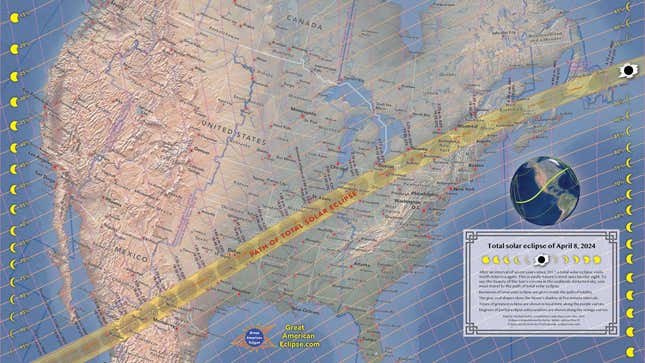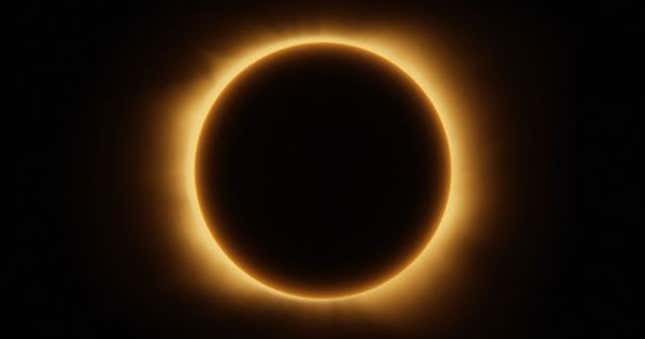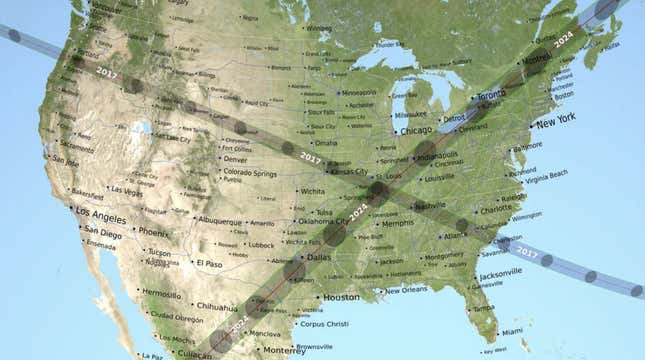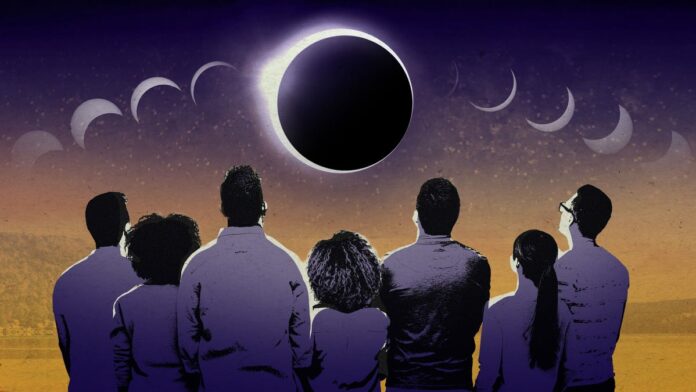Millions of people across North America will soon have the opportunity to witness a rare and special astronomical event — a total solar eclipse — during which the Moon will completely obscure the Sun along an exceptionally long path of totality. To prepare you for the Great North American Solar Eclipse, we’ve put together this handy pocket guide.
Gonna date myself here, but I vividly remember the total solar eclipse of February 26, 1979. I was just 8 years old at the time, and being of unripened age, I failed to appreciate the fact that a total eclipse of this magnitude would not darken my skies for another 45 years.
Indeed, the 2024 Great North American Solar Eclipse marks a significant astronomical event, being the first total eclipse (as opposed to an annular or partial eclipse) to grace the Canadian provinces since 1979, the first to be visible in Mexico since 1991, and the first to sweep across the United States since 2017. For North Americans, nothing will compare until the total solar eclipse of 2045, and for Canadians not until 2079.
Thankfully, I and many of you reading this article will have the opportunity to witness the next big eclipse, owing to its extremely fortuitous path across the North American continent. Even if you’re not directly inside the path of totality — the narrow strip where the Moon’s shadow falls on Earth and the Sun is completely obscured — you should still be able to experience the eclipse in some form, such as a partial eclipse, where the Moon covers only a part of the Sun.
When and where is the eclipse happening?
Mark Monday, April 8, 2024, in your calendar. On that day, the first land-based observers of the eclipse will experience its onset in Mazatlan, Mexico, after which it will proceed northeast across the United States and ultimately end in Newfoundland, Canada. The width of the path of totality will range between 62 and 71 miles (100 and 115 kilometers).

Observers in 15 U.S. states and five Canadian provinces will be directly under the path of totality, with key cities including San Antonio, Austin, Dallas, Fort Worth, Indianapolis, Cleveland, Buffalo, Rochester, Syracuse, and Montreal (the path of totality is also a short drive from Toronto and Ottawa). As many as 31.6 million people live along the path (compared to 12 million in 2017), with another 150 million people living within 200 miles (322 kilometers) of it, according to NASA.

The NASA table above offers timeframes for select U.S. locations. It’s important to note that the affected areas will experience partial eclipses both before and after totality, as the table illustrates. In Buffalo, for instance, the eclipse will begin with the Moon’s first sliver crossing the Sun at 2:04 p.m. ET. Totality, lasting for two minutes, will occur between 3:30 p.m. and 3:32 p.m. The entire event will conclude by 4:32 p.m., spanning a total duration of 148 minutes.
For observers in Canada, totality will begin at the following times at these locations:
- Hamilton, ON: 3:18 p.m. ET
- Belleville, ON: 3:21 p.m. ET
- Montreal, QC: 3:26 p.m. ET
- Fredericton, NB: 4:33 p.m. NB
- Summerside, PEI: 4:27 p.m. AT
- Gander, NL: 5:12 p.m. NT
This guide will help you to find out the exact time based on your location, whether inside or outside the path of totality. Indeed, areas outside the path should still expect to see a dazzling display, so don’t be discouraged. In New York City, for example, approximately 90% of the Sun will be obscured, which is significant. During the recent “ring of fire,” or annular, eclipse that swept through parts of North America on October 14, 2023, partial views were still fantastic and jaw dropping; seeing a big chomp being taken out of the Sun is always enough to elicit goosebumps.
What’s going to happen?
Simply, the Moon is going to pass in front of the Sun from our perspective on Earth’s surface. Within the path of totality, it’ll result in the complete but temporary obscuration of the Sun. Depending on the exact vantage point, the length of time for this event could last for more than four minutes, and that doesn’t include the time it takes for the Moon to progress toward totality and then drift away.

During totality, the sky will be discernibly darkened; it’ll feel as though it’s dawn or dusk. Excitingly, observers using special equipment, such as solar filters or eclipse glasses, should be able to see the Sun’s corona (i.e. outer atmosphere) along the outer perimeter of the blackened disc. This is weather permitting, of course, but the effect of darkness setting in will be experienced regardless of the cloud cover.
If you’re lucky, you may witness a phenomenon known as Baily’s Beads. This happens just before and after totality, appearing as small, bright spots of light around the Moon’s edge. Baily’s Beads are caused by sunlight shining through the rugged lunar terrain’s valleys and mountains. A related effect is the diamond ring—when a single bright spot of sunlight shines through a valley on the moon’s edge against the darkened Sun.
You should also expect to see shadow bands—thin, wavy lines of alternating light and dark that can be observed on plain-colored surfaces (including the sides of buildings) just before and after totality. Shadow bands are caused by the Earth’s atmosphere distorting the sunlight as the Moon covers or uncovers the Sun.
Why this eclipse is special
As already mentioned, the Great North American Solar Eclipse is notable for its long and fortuitous route across North America, but it’s special for reasons beyond that.
The eclipse coincides with a period of increased solar activity known as the solar maximum (the Sun works in 11-year cycles). This is great news for both sky watchers and scientists, as the increased solar activity, such as solar flares and coronal mass ejections, should result in a more vibrant, active, and dynamic corona. Stellar scientists will take the opportunity to study the Sun and its corona, and also phenomena like geomagnetic storms, during the eclipse. NASA has a bunch of citizen science projects related to the eclipse, and the Sun in general.
In recent years, two spacecraft missions have been sent to study the Sun’s corona, namely NASA’s Parker Solar Probe and the Solar Orbiter, the latter a joint mission of ESA (European Space Agency) and NASA. These missions offer direct insights into the corona, but the upcoming eclipse will allow for comparative analyses with ground-based measurements.
Excitingly, the Moon is closer to Earth than it was during the 2017 eclipse, so it will appear slightly larger, thereby extending its sojourn across the Sun. As NASA points out, this will result in a prolonged period of totality and darkness; durations of the 2017 event were around 2 minutes and 40 seconds, whereas the 2024 eclipse will result in periods of totality stretching for upwards of four minutes. That said, the closer you are to the center of the path, the longer the period of totality.

Remarkably, the town of Carbondale in southern Illinois holds a unique position, as it was situated directly in the path of totality for the 2017 eclipse and will be again for the 2024 eclipse.
Another fun fact about this eclipse is how it’ll coincide with another celestial event: the appearance of comet 12P/Pons-Brooks. This comet, nicknamed the “Devil Comet” for its two-pronged and horn-like appearance, could be visible around this time with telescopes or binoculars. As Orbital Today says, “while it is uncommon, there have been instances where comets have been visible during a solar eclipse when the darkness brought about by the eclipse makes the sky appear like nighttime during the day.” Which raises something else to be aware of: with the darkened sky, you should also expect to see stars and planets, namely Jupiter and Venus.
Beware serious eye damage
Please, please, please do not observe the Sun with your bare eyes. It could result in retinal burns, a condition otherwise known as solar retinopathy. The resulting ocular lesions arise “from unprotected solar eclipse viewing and also from minimal gazing at the sun,” according to a 2013 study published in Case Reports in Ophthalmological Medicine.
The retina, perhaps unfortunately, is not sensitive to pain, giving the illusion that everything’s okay and that damage isn’t being done. But make no mistake—damage is most certainly being done when the retina is exposed to the Sun’s dangerous ultraviolet (UV) rays. Symptoms like vision loss, distortion, or color changes may emerge hours later. Retinal damage, which can be temporary or permanent, can occur within seconds of Sun exposure.
How to safely watch the eclipse
Thankfully, there are many ways to experience the upcoming eclipse that don’t involve looking directly at the Sun. You should view the Sun through eclipse glasses (NOT regular sunglasses), handheld solar viewers, or pinhole projectors. Photographers will likewise need to employ specialized solar filters (NOT eclipse glasses) to prevent telescopes and cameras from getting fried.
As NASA points out, you “can view the eclipse directly without proper eye protection only when the Moon completely obscures the Sun’s bright face–during the brief and spectacular period known as totality,” adding that the moment you “see even a little bit of the bright Sun reappear after totality, immediately put your eclipse glasses back on or use a handheld solar viewer to look at the Sun.”
So yes, if you’re located directly in the path of totality, you will definitely want to take your glasses off to experience the spectacle, including the darkness. But to be crystal clear, this is a privilege reserved exclusively for those experiencing totality; even a glimmer of the Sun is potentially enough to damage your eyes.
Hopefully, the weather will cooperate when the big moment arrives, but by remaining safe and prepared with alternative viewing methods, you should still be able to enjoy the eclipse regardless of the conditions.
A version of this article originally appeared on Gizmodo.


